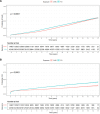Percutaneous vs. surgical revascularization of non-ST-segment elevation myocardial infarction with multivessel disease: the SWEDEHEART registry
- PMID: 39601339
- PMCID: PMC11804248
- DOI: 10.1093/eurheartj/ehae700
Percutaneous vs. surgical revascularization of non-ST-segment elevation myocardial infarction with multivessel disease: the SWEDEHEART registry
Abstract
Background and aims: The long-term outcomes of percutaneous coronary intervention (PCI) vs. coronary artery bypass grafting (CABG) in patients with non-ST-segment elevation myocardial infarction (NSTEMI) and multivessel disease remain debated.
Methods: The Swedish Web-system for Enhancement and Development of Evidence-based care in Heart disease Evaluated According to Recommended Therapies registry was used to analyse 57 097 revascularized patients with NSTEMI with multivessel disease in Sweden from January 2005 to June 2022. The primary endpoint was all-cause mortality, encompassing both in-hospital and long-term mortality; the secondary endpoints included myocardial infarction (MI), stroke, new revascularization, and heart failure. Multilevel logistic regression with follow-up time as a log-transformed offset variable and double-robust adjustment with the instrumental variable method were applied to control for known and unknown confounders.
Results: Percutaneous coronary intervention was the primary therapy in 42 190 (73.9%) patients, while 14 907 (26.1%) received CABG. Percutaneous coronary intervention patients were generally older with more prior cardiovascular events, whereas CABG patients had higher incidences of diabetes, hypertension, left main and three-vessel disease, and reduced ejection fraction. Over a median follow-up of 7.1 years, PCI was associated with higher risks of death [adjusted odds ratio (aOR) 1.67; 95% confidence interval (CI) 1.54-1.81] and MI (aOR 1.51; 95% CI 1.41-1.62) but there was no significant difference in stroke. Repeat revascularization was three times more likely to PCI (aOR 3.01; 95% CI 2.57-3.51), while heart failure risk was 15% higher (aOR 1.15; 95% CI 1.07-1.25). Coronary artery bypass grafting provided longer survival within 15 years, especially in patients under 70 years of age, with left main disease or left ventricular dysfunction, though this benefit diminished over shorter time horizons.
Conclusions: Coronary artery bypass grafting is associated with lower risks of mortality, MI, repeat revascularization, and heart failure in patients with NSTEMI, particularly in high-risk subgroups. However, its survival benefit lessens with shorter life expectancy.
Keywords: Coronary artery bypass grafting; Multivessel disease; Non-ST-segment elevation myocardial infarction; Percutaneous coronary intervention; Revascularization.
© The Author(s) 2024. Published by Oxford University Press on behalf of the European Society of Cardiology.
Figures







References
Publication types
MeSH terms
LinkOut - more resources
Full Text Sources
Medical
Miscellaneous

